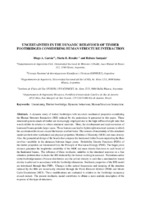Uncertainties in the dynamic behaviour of timber footbridges considering human structure interaction
Date
2018-11-09Author
García, Diego Alberto
Rosales, Marta Beatriz
Sampaio, Rubens
Metadata
Show full item recordAbstract
A dynamic study of timber footbridges with uncertain mechanical properties considering the Human Structure Interaction (HSI) induced by the pedestrians is presented in this paper. These structural systems made of timber are increasingly employed due to the high stiffness/weight ratio that wood exhibits in relation to thers structural materials. More, the development and implementation of laminated beams permits larger spans. These features can lead to lightweight structural systems in which the acceleration levels can exceed the human comfort limits. The sources of uncertainty of this structural model are the timber mechanical and physical properties, Modulus of Elasticity (MOE) and mass density. Also, the eometrical design of the boards that compose the laminated timber beams upporting the floor involves variability in the distances between finger joints. Probability Density Functions (PDFs) of the timber properties are formulated from the Principle of Maximum Entropy (PME). The finger joints distance generates the lengthwise variability of the MOE and mass density functions in each board of the laminated beams. The influence of these stochastic variables in the structural esponse on a free vibration problem that includes the HSI induced by the human walking is assessed. Pedestrians arrive to the footbridge under a Poisson distribution and the arrival velocity is such that a medium/low transit density is chieved in accordance with the footbridge dimension. Stochastic properties of the HSI model are introduced through their PDFs. Changes in the natural frequencies and damping of the structure induced by the HSI are numerically obtained through the Finite Element Method (FEM) and Monte Carlo Simulations (MCS). These odifications are evaluated in relation to the footbridge occupancy
at each instant. The present stochastic model contributes to obtain a more realistic description of the response of this type of structures.
Collections
The following license files are associated with this item:




